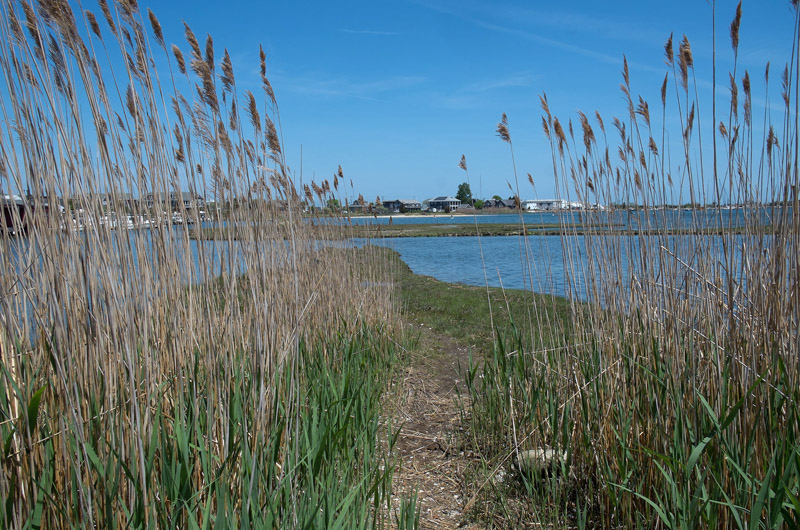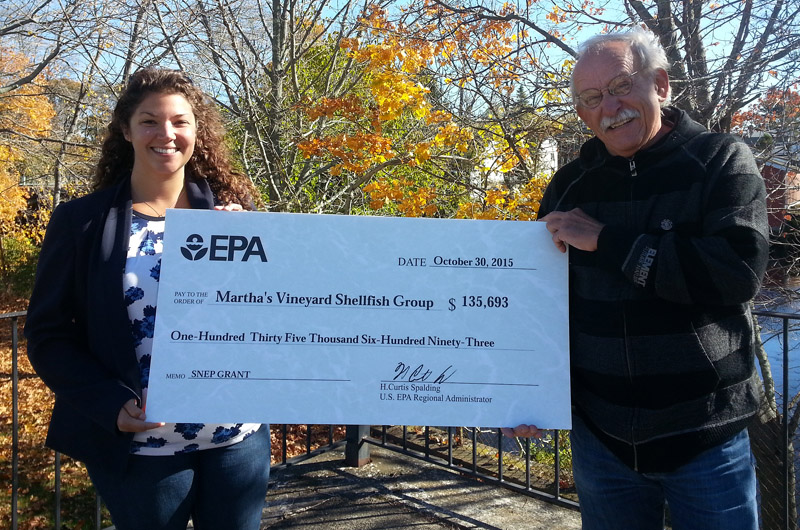The Martha’s Vineyard Shellfish Group on Friday accepted a large federal grant that will allow it to continue studying the invasive wetland grass phragmites, which it believes could play a role in reducing the amount of nitrogen in coastal ponds.
With the $135,693 grant the shellfish group was among several groups in the region that received funding from the Environmental Protection Agency at a ceremony in Taunton on Friday. A total of $5 million will fund coastal restoration efforts in Rhode Island and Massachusetts, including about $1.5 million distributed through the EPA’s Healthy Communities Grant Program.
Several of the regional projects focus on nitrogen, a nutrient that enters coastal ponds from septic systems, runoff and other sources. Too much nitrogen has led to algal blooms and a loss of pond habitat throughout the region. Some organisms, however, including phragmites, seem to benefit from the excess nitrogen.
With funding from the Edey Foundation in 2013, the shellfish group began studying phragmites, which arrived with the early settlers and often grows along the edges of coastal ponds. The tall, sturdy reed is often considered a pest, but the shellfish group is hoping to turn the tables by harvesting it in nitrogen-impaired areas and using it for biofuel and animal feed.
The Healthy Communities grant will support the shellfish group and a coalition of local organizations, including the Martha’s Vineyard Commission and the University of Connecticut, that will work to determine the plant’s ability to absorb nitrogen, along with the feasibility of harvesting and production. The idea is to remove nitrogen from coastal ponds by repeatedly harvesting the plants.
Over the last two years, the shellfish group has collected samples from along Lagoon Pond on the Vineyard Haven side, and had them analyzed at the Marine Biological Laboratory in Woods Hole. Shellfish group special projects coordinator Emma Green-Beach, who is heading the project, found that an acre of phragmites could contain as much nitrogen as a half a million cultured oysters. Harvesting the phragmites, like the oysters, could remove the nitrogen.
Local officials believe that a range of approaches, including expanded sewering and newer denitrifying septic systems will be needed to preserve the Island’s coastal ponds. But many of those solutions do nothing to reduce the amount of nitrogen already in the water.
The state Department of Environmental Protection does not officially recognize the role that phragmites (and shellfish) could play in removing nitrogen from coastal ponds. But that is partly what the shellfish group hopes to change with its research.

“We are going to make a hell of an effort to try to gather the information that we believe would make a strong case for [recognition],” shellfish group director Rick Karney said Friday. “We are testing the hypothesis that yes, this is one way to capture and remove a lot of nitrogen.”
The study will focus on a densely-grown area on Chilmark Pond owned by the Sheriff’s Meadow Foundation. Jamie Vaudrey, a professor of marine science at the University of Connecticut, will examine how nitrogen cycles through the plants as well as their environment. The two-year study may also reveal how the harvests affect subsequent generations in the area.
“A lot of this would be applicable elsewhere, both on the Island and anywhere phragmites grows,” Mr. Karney said. “It gets in a lot of places.”
The shellfish group hopes to work with the MVC to map areas of phragmites around the Island, and to conduct public outreach related to the project.
Others will investigate the plant’s potential in agriculture and as a biofuel. Mermaid Farm, about a mile and a half north of the pond, will explore uses such as composting, bedding and animal feed, while Nathaniel Mulcahy, founder of WorldStove, which has developed high-efficiency stoves for communities around the world, will help create fuel pellets from the harvested plants. The byproduct, biochar, can be used as an additive in sandy soil.
Mr. Karney expected to have a signed contract with the EPA in the next couple of weeks, after which the project could begin. Oak Bluffs conservation agent Elizabeth Durkee will help determine what permits are required for harvesting the plants.
Earlier this year, the phragmites project was denied funding by the Woods Hole Sea Grant Program. But Mr. Karney pointed out that the EPA grant provides more money and requires a smaller match from the community. He said the match would come largely in the form of donated time.
He believed the EPA had appreciated the innovative nature of the proposal, along with the involvement of community groups around the Island and the potential for a self-sustaining program in the future. “They wanted to make sure that it had some sense in reality of actually being applied at some point,” he said. “And I think we made a strong case.”








Comments (5)
Comments
Comment policy »